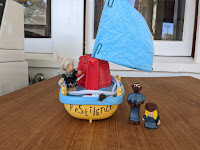So I could technically call this done, but it doesn't "feel" done, it feels like I dipped my toes in with an easy-to-do project when my real ambition was to swim to the other side of the lake.
Prototype 1: My Fairy Garden Playset bday gift for kid. It was something crazy like $12. Now between Black Friday and Cyber Monday it is listed at $38. This got some modifications-- hubby drilled holes in the moat for drainage and I topped it up with potting soil since the peat cubes were not enough. I then reseeded it with Botanical Interests Fairy Meadow flower mix that was a prior gift to me from MIL. They seem to be doing OK, but need vigilant watering because the moat is so shallow it dries out very quickly. The solar panel is still turning the windmill a month and a half after kiddo's bday.
This plastic confection isn't exactly what I had in mind for fairy gardening. I'm more into the delightfully miniaturized ephemera of daily living strewn in surprising places around the garden to encourage more puttering out there.
Other ideas: polymer clay dough gnomes. Maybe one that looks deceptively strawberry-like to hide where they grow. Maybe one that looks like Ron Finley, gangsta gardener. We sat in on an airbnb experience he hosted pre-2020 and were amazed at his lunker sweet potatoes growing on the median. Ollas keep those going? Really? I also binge watched his Masterclass last week while super under the weather from a covid booster and difficulty sleeping. While I'm making a Ron minifig, why not some "homie gnomies" with LPS (local gang but also very close to a Finleyism of Let's Plant Shit). To be continued!
1/14/22: So I've made a Ron Finley gnome that is more super glue than clay. Giving him a ball head and tiny arms with no reinforcement meant things snapped too easily. He hung out in the peas by a divided aloe for a while until my kid took him to a food dessert (her Ruby's mac n cheese + fries to go box).
2/7/22: I made a Jesse Krebs. She is stubbier and even said she was "OK looking like a lump in the field" if that meant she wore roomier men's clothes she could stuff with insulation. I reinforced her neck area with blonde hair and a hat, kind of like those gnomes with beards and you only see their noses. I ran a needle and cordage through her hat. She has a weird habit of rocking back on her base and ending up in a supine position, but that was one of her big points in her survival class anyway-- chill out, don't burn energy panicking. Going to call that a bug not a feature.2/13/22: Inspiration for this was sparked by seeing a bee struggling to get out of our blue barrels of rainwater and wanting some sort of gnomish raft. Then I remembered the Moxie Marlinspike Hold Fast documentary about the anarchist yacht club and spent a date night rewatching that with rapid-to-buy-a-boat hubby.
This one was surprisingly easy to pull together. The ethic of borrowing/stealing little-used equipment and muddling through diy without the help of expensive ordained Experts put some wind in my metaphorical sails. The derelict plastic boat happened to have been abandoned on our shower floor. It hadn't moved positions for several days, so I don't think DD will much miss it. Like the real boat, it had routinely had a mildew problem and taking it apart to spray its hull with bleach so that my soul would hurt less watching DD sip bath water from its spout. I didn't borrow someone's dinghy crane to get the aluminum sail (a metal straw issued by DH's company to celebrate their Zoom-hosted pandemic Tikki holiday party). But I did need a demo from him on how to seat a drill bit in a drill and then find a girthier bit in the depths of the shed. The sail itself was a parachute for a cheap Valentine's day toy DD had quickly tangled into a hopeless knot and lost interest in. I tried to staple a little black anarchy flag in there for good measure as well. Moxie himself I fashioned out of 2 unraveled paper clips, after learning nothing happens to baked needles and thread with the Jesse gnome. He has a pretty ectomorphic build that seemed to work well with a metal skeleton. I put him in a pink bikini as per the documentary. I stuck a leftover bit of paper clip in his hand so he has the option to string a fishing line off it or club whatever dorado he happens to catch senseless. After baking, I glued on dog fur I had rolled into dreads and a scrap of worn ragged black shirt of my husband's. Pony tail elastic for belt and an old swim short shoelace waistband to keep him from tipping off the boat (I had also discovered with Jesse that polymer gnomes generally sink). I'd like to eventually pair him with Anne Bonny and Mary Read after a Neil Gaiman masterclass segment read his March Story and piqued my interest in female Caribbean pirates and because the Pestilence crew kinda had a similar lesbos feel to it without outright discussing the interpersonal dynamics of its members.










